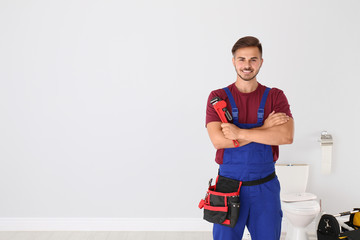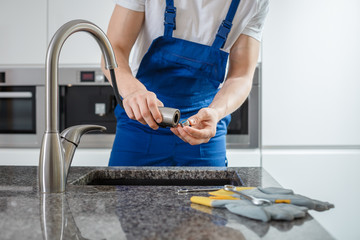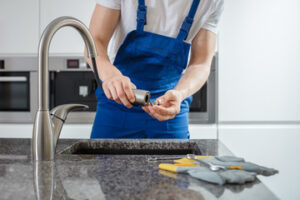Plumbing is a hands-on career that requires physical strength and a strong work ethic. It is a rewarding job that contributes to the comfort and safety of homes and businesses.
Plumbers Bradenton install plumbing systems in new buildings, ensuring that pipes and fixtures comply with local building codes. They also repair and maintain existing plumbing systems.
Plumbers install new plumbing systems in homes, businesses, and industrial settings. They follow blueprints and building codes to ensure the new pipes and fixtures are placed in the correct locations, connected properly, and able to meet the needs of the occupants. This work requires considerable physical stamina and attention to detail to keep up with demands of the job.
Plumbers also inspect existing plumbing systems to identify issues and potential problems. They use specialized tools to check for leaks in pipes, clogs, and other problems that may require repair or replacement. They can test water pressure to ensure it is within the recommended range and look for signs of corrosion, such as rust or discoloration in the water. In addition, they can install and repair appliances such as sinks, toilets, showerheads, and water heaters.
When conducting a home inspection, a plumber will examine all visible pipes for issues like corrosion, cracks, and leaks. They will test the water flow rate to ensure it is adequate for fixtures and appliances, and look for signs of sewage backflow or drain lines that aren’t functioning properly. They will also test for proper drainage by running water through the pipes and observing how quickly it disappears from sinks, bathtubs, and showers.
A good plumber will take the time to protect the home or business they’re working in, making sure to cover floors with plastic sheets and carefully place items on top of them that can be damaged by saws or other power equipment. They will also clean up their workspace at the end of the day, leaving no trace they’ve been there. A true professional takes pride in their work and is happy to show off their skillset to clients.
Another common place for plumbers to work is on construction sites. They’ll work alongside other tradespeople to lay out piping systems according to the building plans and specifications. In this role, they’ll need strong communication skills to discuss plans with other professionals and ensure everyone understands what needs to be done. They’ll also need to be able to read and interpret blueprints and other technical documents.
Maintenance
Plumbers must remain up-to-date on all new plumbing technologies and equipment. They also need to keep abreast of changing environmental regulations and compliance standards. This is especially important since many plumbing jobs require the use of chemicals and other potentially harmful substances. Regular training ensures that they are using the latest tools and techniques to reduce the risk of accidents and injuries.
As they install new plumbing systems, plumbers often work closely with construction teams and architects to lay out piping according to blueprints and specifications. They may also be responsible for testing and inspecting completed plumbing installations to ensure they meet all relevant safety requirements. Plumbers who specialise in maintenance may work on plumbing systems in offices, retail stores, hospitals, and other large commercial or industrial buildings. These larger-scale plumbing projects can involve installing and repairing complex water supply lines, drainage systems, and fire sprinkler systems.
The plumbing industry is regulated by local government bodies, and plumbers must comply with all relevant laws and standards. This can include obtaining a licence, insurance coverage, and certification to perform certain tasks. It is essential that plumbers stay current with all regulatory requirements in their area, as they can be subject to fines if they do not adhere to local standards.
Besides working on plumbing systems, plumbers also provide maintenance services to households and businesses. This may include fixing toilets and faucets, repairing or replacing damaged appliances, and performing annual maintenance. They can also help customers choose and install energy-efficient plumbing systems to cut down on utility bills.
Many plumbers also start their own plumbing businesses, which gives them the freedom to set their own rates and schedules. This can be a rewarding career path, but it requires a lot of hard work and dedication to build a strong reputation. Plumbers must also be prepared for emergency calls, such as burst pipes or sewage backups, which can disrupt their schedules and require them to work outside of normal business hours.
Plumbers are vital members of our society, as they make sure that we have access to clean water and proper waste disposal. Their work directly impacts our health and wellbeing, from practicing hygiene to sanitizing operating rooms. Choosing to become a plumber can be a rewarding experience, as it allows you to contribute to public health and wellbeing while enjoying a flexible schedule and good pay. However, it’s important to understand the pros and cons of this job before you decide to pursue it.
Repair
Plumbing is considered a “recession-proof” trade because every home and business needs functioning water and sewage systems. Plumbers can repair or replace these systems, install fixtures and appliances, and make inspections to ensure the safety of a building’s occupants.
A professional plumber will thoroughly inspect a client’s plumbing system and address any issues that need to be fixed immediately. After completing the inspection, the plumber will provide a detailed report explaining what was checked, results of the evaluation and recommended repairs. This allows homeowners to decide which fixes are a priority and what can wait. If a homeowner chooses to do some of the repair work himself, the plumber can offer tips and advice, such as using energy-saving fixtures, upgrading old pipes or installing a tankless water heater.
Plumbers will look at each of the home’s plumbing fixtures to examine their condition and operation. This includes sinks, faucets, showerheads and toilets; drains; and the water heater. The plumber will check for signs of leaking, cracks, corrosion, water flow and drainage problems. The plumber will also look at each pipe in the house to see if they are supported, have proper slope and are free of obstructions.
If a home is on a well, the plumber will check the pump and pressure; test for gas leaks; and inspect the water for quality and contaminates. The plumber will also check the home’s septic system for proper operation and location of tanks, as well as the sewer line connecting to the municipal waste systems.
Many potential hazards can be identified during a plumber’s inspection, including electrical wiring that is exposed or has improper supports; carbon monoxide leaks from furnaces and water heaters; and cross-contamination between a building’s water systems. Plumbers can advise clients of these and other safety issues and recommend upgrades to prevent future problems. They can also help clients create a plumbing budget and schedule for addressing any needed repairs. Plumbing is an essential service and skilled plumbers are in high demand. Those interested in becoming plumbers can start by earning a high school diploma or GED certificate, then enrolling in an apprenticeship program. Apprenticeships can last from two to five years and provide hands-on training while allowing the student to learn the skills of the trade.
Troubleshooting
Troubleshooting is the process of identifying and solving equipment failures to bring the system back into operation. The goal is to strengthen the system against future problems by addressing issues that could lead to repeat failures. This approach differs from the quick fixes often applied by homeowners, such as turning equipment off and on or changing a setting.
The troubleshooting process requires careful analysis of the symptoms and the environment in which the problem occurs. Experience allows troubleshooters to hypothesize possible causes of the issue, which they then test through experimentation or logical deduction. This step also includes considering any recent changes or events that could have contributed to the problem.
The elimination process is an effective method of narrowing down potential causes. By eliminating possibilities one by one, troubleshooters can pinpoint the cause of the problem and implement a solution. This process can be time-consuming, but it ensures that the problem is thoroughly examined and solved. The end result is a functioning system with improved reliability and performance. A well-trained troubleshooter can resolve even the most difficult problems efficiently and effectively.



